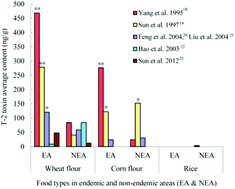The effects of T-2 toxin on the prevalence and development of Kashin–Beck disease in China: a meta-analysis and systematic review
Abstract
To reveal the influence of T-2 toxin detection rate and detection amount in food samples on Kashin–Beck disease (KBD), and define a linking mechanism between T-2 toxin induced chondrocytes or cartilage damage and KBD pathological changes, seven electronic databases were searched to obtain epidemiological and experimental studies. For epidemiological studies, subgroup analyses of the positive detection rate (PDR) of the T-2 toxin and PDR of the T-2 toxin with concentrations (PDRC of T-2) >100 ng g−1 were carried out, together with a histogram of the T-2 toxin concentrations in different food types in KBD and non-KBD areas. For experimental studies, a systematic review of a variety of chondrocyte and cartilage changes and damage induced by the T-2 toxin was performed. As a result, in epidemiological studies, meta-analysis demonstrated that the T-2 toxin PDR and the overall PDRC of T-2 toxin >100 ng g−1 showed a slightly significant increase in KBD areas than that in non-KBD areas separately. From the histogram, T-2 toxin accumulation was more serious in endemic areas, especially in wheat flour samples. In experimental studies, the T-2 toxin could induce damage of chondrocytes and cartilage, and inhibit cell proliferation by promoting apoptosis and catabolism as well as intracellular injuries, which is similar to the characteristics of KBD. In conclusion, the amount of T-2 toxin detected has a more significant influence on KBD prevalence and development as compared to the T-2 toxin detection rate. Besides, the T-2 toxin induces chondrocyte and cartilage damage through apoptosis, catabolism promotion and intracellular impairment, which is similar to the KBD change.


 Please wait while we load your content...
Please wait while we load your content...